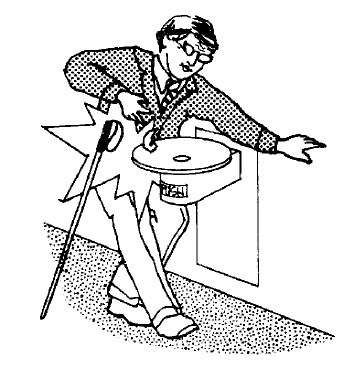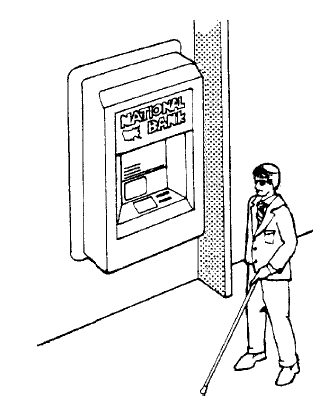Withdrawn Technical Assistance: Common ADA Errors and Omissions in New Construction and Alterations
Circulation Paths
Error/Omission:
Objects protrude into circulation paths from the side or from posts.
Objects that overhang circulation paths do not provide clear headroom.

Result:
People who are blind or who have low vision can be seriously injured when they cannot detect an object by using the sweep of their cane.
Requirement:
4.1.2 (3) All objects that protrude from surfaces or posts into circulation paths shall comply with 4.4.
4.1.3 (2) All objects that overhang or protrude into circulation paths shall comply with 4.4.
4.4.1* General. Objects projecting from walls (for example, telephones) with their leading edges between 27 in and 80 in (685mm and 2030 mm) above the finished floor shall protrude no more than 4 in (100 mm) into walks, halls, corridors, passageways, or aisles (see Fig. 8(a)). Objects mounted with their leading edges at or below 27 in (685 mm) above the finished floor may protrude any amount (see Fig. 8(a) and (b)). Free-standing objects mounted on posts or pylons may overhang 12 in (305 mm) maximum from 27 in to 80 in (685 mm to 2030 mm) above the ground or finished floor (see Fig. 8(c) and (d)). Protruding objects shall not reduce the clear width of an accessible route or maneuvering space (see Fig.8(e)).

4.4.2 Head Room. Walks, halls corridors, passageways, aisles, or other circulation spaces shall have 80 in (2030 mm) minimum clear head room (see Fig. 8(a)). If vertical clearance of an area adjoining an accessible route is reduced to less than 80 in (nominal dimension), a barrier to warn blind or visually-impaired persons shall be provided (see Fig. 8(c−1)).
* Asterisk denotes that related, non-mandatory material is in the Appendix to the Standards.

User Comments/Questions
Add Comment/Question